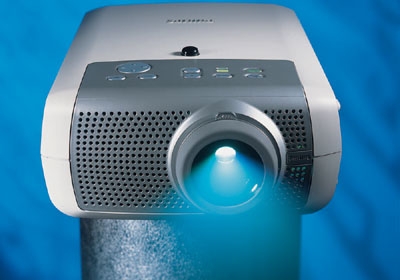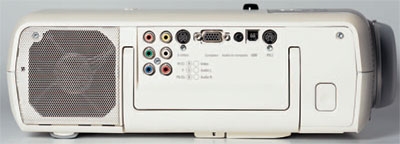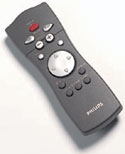LCD for Less Page 2

Like its solitude-craving namesake, the Philips Garbo ($2,495) makes a big effort to fade into the background where it won't be noticed - a positive trait for a video projector. Shoebox-sized, it has a slim footprint, and its off-white case will blend seamlessly into most ceilings if you use the optional $175 mount. Most important, the projector's whisper-quiet cooling fan won't distract you when watching silent movies like those Greta Garbo started out in.
With our screen, the setup range afforded by the Garbo's 1.2x zoom lens was 11 7/8 to 14 5/8 feet. Like the Panasonic projector, its 858 x 484 resolution is a perfect match for DVD but not enough for HDTV. The Garbo can accept video signals in all four common formats - standard 480i and 480p as well as high-definition 720p and 1080i - but all are displayed at 480p. However, when I used an A/V receiver to switch between video signals in different formats and send them to the projector's component-video input, it often had trouble "locking" onto the new signal. To get any image at all, I had to toggle through the various inputs until I was back where I started. 
In addition to its component-, composite, and S-video jacks, the Garbo has a VGA-style RGB input for connecting a computer or HDTV tuner. Other jacks include USB and PS/2 mouse-output ports. When the projector is used as a computer monitor, connecting your PC to either of these jacks lets you use the projector's remote control as the PC's mouse.
 The remote is a throwback to LCD's pre-home theater days. Tiny, with minuscule buttons, none of which are backlit or clearly labeled, it will have you reaching for a flashlight every time you want to control the projector. Pressing the Source button toggles through the inputs. To switch display modes, however, you have to dig through the Picture menu - a process that requires a bunch of button pushes. In addition to standard 4:3 and 16:9, the Garbo's display modes include Movie Expand 16:9. This will blow up the letterboxed programs they sometimes show on the Turner Classic Movies channel to fill a 16:9 screen without distorting them. A similar mode lets you adjust the picture vertically to accommodate programs with subtitles.
The remote is a throwback to LCD's pre-home theater days. Tiny, with minuscule buttons, none of which are backlit or clearly labeled, it will have you reaching for a flashlight every time you want to control the projector. Pressing the Source button toggles through the inputs. To switch display modes, however, you have to dig through the Picture menu - a process that requires a bunch of button pushes. In addition to standard 4:3 and 16:9, the Garbo's display modes include Movie Expand 16:9. This will blow up the letterboxed programs they sometimes show on the Turner Classic Movies channel to fill a 16:9 screen without distorting them. A similar mode lets you adjust the picture vertically to accommodate programs with subtitles.
As with other fixed-pixel projectors, setting up the Garbo was a piece of cake. After manually adjusting the zoom and focus rings on the lens, I used the keystone correction in the settings menu to tweak image geometry. The projector's horizontal/ vertical shift adjustment also let me align my progressive-scan DVD player's picture, which tends to shift to the left a few pixels. Any picture adjustments you make to the Garbo during setup are stored in memory. It seemed like you could save custom settings for each of the projector's inputs, but for some strange reason the sharpness control tended to "stick," retaining its previous setting whenever I switched between sources.
|
After choosing Natural color tracking from the picture menu (the other option, Vivid, is for computer images), I selected the Warm color-temperature option and made some adjustments to the red, green, and blue color controls (see "in the lab," facing page, for details). A scene of sandlot baseball in The Rookie was very crisp, with rich colors and very little artificial-looking enhancement on the edges of a bat or the batting cage. Skin tones were natural for the most part, though I did detect an orange-red tinge to faces in some scenes.
The picture looked considerably softer when I switched over to the projector's standard (480i) inputs. It also lacked 2:3 pulldown for film-based programs on DVD or cable TV, which caused diagonal lines to break up into "stairstep" patterns in certain shots. For both of these reasons, I'd recommend pairing the Garbo with a progressive-scan DVD player and investing in an outboard line doubler to handle standard (interlaced) video sources like cable and satellite TV.
Many LCD projectors I've tested in the past had a tough time reproducing deep black. But when I watched the Coen Brothers' black-and-white The Man Who Wasn't There, I was pleasantly surprised by the Garbo's black-level performance. Part of this was attributable to the Stewart GrayHawk screen, but the Philips projector delivered reasonably good blacks and a decent amount of shadow detail in a scene where Billy Bob Thornton's character chats with the anguished man he's secretly blackmailing. On a less positive note, a bright sequence inside a barbershop revealed a picture-uniformity problem, which showed up as a pink tint on the right side of the screen. When I went back to watching color programs, however, the problem wasn't nearly as apparent.
As expected, TV programs like a cycling show on ESPN looked soft when I used the composite- and S-video connections and a little clearer when they were upconverted to a high-def format by my cable receiver. But the cycling program and almost everything else I watched on the Garbo looked dim. From my seating position 14 feet away I also noticed the screen-door effect.
Philips's small, silent, and reasonably priced Garbo is a good way to get big images without depleting your living space or savings account. While not the best in its class, its video performance was reasonably good. Just remember to use a progressive-scan DVD player.
- Log in or register to post comments




















































